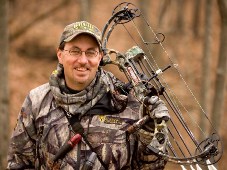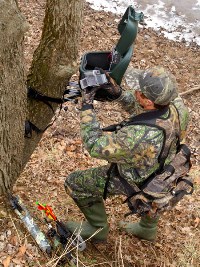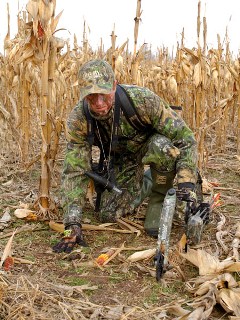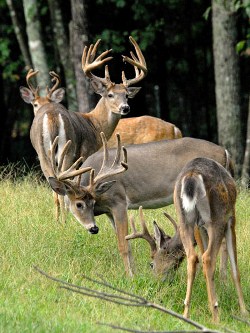with Mark Drury by John Phillips | July 07, 2010
 Editor’s Note: Mark Drury of Osceola, Iowa, the founder of MAD Calls, the co-owner of Drury Outdoor Productions with his brother Terry and a long-time avid deer hunter, is a dyed-in-the-wool Mossy Oak enthusiast. Each year, Drury hunts in several states and consistently takes big bucks for his videos. But how does anyone take big bucks regularly? Drury explains how starting early and using new technology helps him find bucks, learn their haunts and habits and determine when and where he can expect to take one.
Editor’s Note: Mark Drury of Osceola, Iowa, the founder of MAD Calls, the co-owner of Drury Outdoor Productions with his brother Terry and a long-time avid deer hunter, is a dyed-in-the-wool Mossy Oak enthusiast. Each year, Drury hunts in several states and consistently takes big bucks for his videos. But how does anyone take big bucks regularly? Drury explains how starting early and using new technology helps him find bucks, learn their haunts and habits and determine when and where he can expect to take one.
Secret No. 1:
I plant green fields with Mossy Oak BioLogic in areas where I have easy access with my truck to study the green fields, but I don’t plan to hunt them. I plant long narrow strips that are invisible from a public road. During the summer months, the wind direction in our section of the country often is a south wind so I plant these strips where I can either walk in or drive in and scout them with a south wind. Then the deer won’t smell me. I plant two different types of green fields – observation fields that allow me to see the deer on the property during the summer months and hidey-holes that will hold deer, so I can hunt them there. The way you plant your green fields determines whether you’ll be able to scout successfully for deer season or not.
Secret No. 2:
I start hunting a buck in July when the buck’s antlers are just beginning to develop. Learn which green fields bucks are coming to, and which green fields that does prefer. Identify the trails the deer are using to come into green fields, and put motion-sensor cameras along these trails to get pictures of the bucks. Then I know which green fields each buck is utilizing. This tactic cuts my scouting time because as I develop the pictures, I know which fields I’ll be hunting when deer season starts. I number my camera stations to know exactly which photos have been taken where. Trail-monitoring cameras enable a hunter to find big bucks, and to know where they’re moving quickly and easily and what time of the day or night they’re moving and how big the deer are. My trail cameras have taught me that the deer often don’t move much during the summer months. They generally move in the morning and evening, just like they do during hunting season. Another interesting fact I have learned is that bucks tend to move more than does during the summer months. And when I’m scouting, I always wear Mossy Oak camouflage.
Secret No. 3:
Deer change their nutritional needs from green fields to soybean fields as the summer progresses in Missouri, my home state. One of the keys to scouting is noticing when the deer switch their feeding patterns and then moving motion-sensor cameras to new trails to keep-up with deer movement. When the Missouri deer leave my green fields and go to soybean fields in August, I change my cameras from the green fields and put them on trails leading to soybean fields and other agricultural crops to learn which bucks are going to these new fields. For trail cameras to be effective, you have to move the cameras as the deer change food sources. If you do, you can keep up with the location of the bucks on the property and watch these bucks’ antlers grow and develop. Another advantage to using the trail cameras is that you disturb the areas where you plan to hunt very little and have little human impact on the deer.
Secret No. 4:
 You must know when to go to the camera. During the summer months, as I’ve said earlier, the deer will move very little. I’ve learned I usually won’t get more than four or five pictures of deer per day on a good trail during July and August. So, I only check my cameras once a week, which keeps me from spending much time in my hunting area. Another big advantage this method of scouting gives me is that I’m scouting every day from 10- or 20-different locations and not leaving any human scent in those regions. I’m not pressuring the deer that I plan to hunt in the fall during the summer months. I usually wear full camouflage, including a head net and gloves when visiting my cameras. I want to get to the camera as quickly and quietly as possible, leave as little human odor I can and be invisible to the deer.
You must know when to go to the camera. During the summer months, as I’ve said earlier, the deer will move very little. I’ve learned I usually won’t get more than four or five pictures of deer per day on a good trail during July and August. So, I only check my cameras once a week, which keeps me from spending much time in my hunting area. Another big advantage this method of scouting gives me is that I’m scouting every day from 10- or 20-different locations and not leaving any human scent in those regions. I’m not pressuring the deer that I plan to hunt in the fall during the summer months. I usually wear full camouflage, including a head net and gloves when visiting my cameras. I want to get to the camera as quickly and quietly as possible, leave as little human odor I can and be invisible to the deer.
Secret No. 5:
I like to actually see the deer, especially the bucks I’ll be hunting in the fall, besides using the trail-timer camera. But once again, I want to see the buck from a distance and not disturb him by getting too close. I’ve learned from my motion-sensor cameras that the first 10 days of a full moon is when I’ll see the most big bucks coming to a green field late in the afternoon. I’ll take advantage of the deer’s reaction to the phases of the moon during the summer months, just as I do during the fall and winter months. I want to see the bucks on the green field to try and determine their personalities and their temperaments. Some bucks will be very bold, while other bucks will be very skittish. Some bucks will walk right out in the middles of the green fields, while other bucks will hold on the edges. By being able to study the bucks through binoculars or spotting scopes from a long distance, I can learn the personality of each buck. If you’re going to go to a green field and study the bucks, you’ll want to go to that field when the most bucks will be on it. I’ve learned that not only most of the bucks, but more importantly most of the big bucks that are using a green field, will be out in that green field early in the afternoon for 10 days after a full moon.
Secret No. 6:
You’ve got to have quality glass to scout for bucks. I want to stay at least 400-yards away from the fields that I’m scouting. For this reason, I’ll usually use 10X binoculars when I’m scouting and/or a spotting scope. Eastern hunters don’t take advantage of spotting scopes nearly as much as western hunters do, and you’ll rarely see an eastern hunter scout with a spotting scope or 10X binoculars. However, remember, the further you stay away from the deer, the less human odor you’ll introduce to your hunting site, and the better your odds are for taking an older-age-class buck. Too, by using quality binoculars and spotting scopes, you can spend more time scouting from your truck, which keeps your human odor in your vehicle. I use a window-mount device for my spotting scope to mount the scope on the window. When I’m out in my truck in the summer scouting, I’m usually only wearing a Mossy Oak t-shirt and shorts with six pockets.
Secret No. 7:
 I’ll begin to move tree stands or set-up new tree stands, as I learn more about the deer from my scouting program. I hang numerous tree stands on the farm I hunt during January and February, after deer season. Then, during July and August, I go check these tree stands to make sure they’re safe and secure. I hang new tree stands to have stands where the deer will be traveling at the beginning of bow season. Two factors determine the day I will hang a tree stand - weather conditions and time of day. In the summer months, I try to hang my tree stands in the middle of the day when the weather’s the hottest, and when I’m almost certain rain will come in the afternoon. Hot weather helps evaporate human odor, and a rain will wash it away. I want all the stands I’ll hunt from during the upcoming season to be in place by the middle of August or the first of September. Then when I start bowhunting in October and November, I’ll have fresh stands to hunt from that don’t have any human odor associated with them.
I’ll begin to move tree stands or set-up new tree stands, as I learn more about the deer from my scouting program. I hang numerous tree stands on the farm I hunt during January and February, after deer season. Then, during July and August, I go check these tree stands to make sure they’re safe and secure. I hang new tree stands to have stands where the deer will be traveling at the beginning of bow season. Two factors determine the day I will hang a tree stand - weather conditions and time of day. In the summer months, I try to hang my tree stands in the middle of the day when the weather’s the hottest, and when I’m almost certain rain will come in the afternoon. Hot weather helps evaporate human odor, and a rain will wash it away. I want all the stands I’ll hunt from during the upcoming season to be in place by the middle of August or the first of September. Then when I start bowhunting in October and November, I’ll have fresh stands to hunt from that don’t have any human odor associated with them.
Secret No. 8:
My brother Terry and I have two different farms that we hunt and try to have 80- to 100-tree stands in place on them. With that-many stand sites, there’s no way we can remember or find all of them. We plot out every tree-stand site with a GPS, log each stand site into the GPS and give each one a name. We also record all of our stand sites’ names, location and every wind direction that particular stand can be hunted from on paper. By using this method, we can turn on our computer in the morning, go to www.weather.com to learn what wind direction we’ll have that day in our area and determine which stands we can hunt with a favorable wind. Then we pick out the stands where we believe our chances are best for taking a buck that day, pull two stand sites up in our handheld GPS, go straight to them in the dark, climb into the trees and are ready to hunt before daylight.
Secret No. 9:
I begin to pick the bucks I want to hunt from the motion-sensor camera information and from observing the deer in the field. The bucks I’ll try to hunt aren’t always the biggest bucks I see. I have to identify which bucks appear on the trails the most often during daylight hours. Some bucks have a tendency not to move until after dark. If you’ll hunt the bucks that move down trails and are in the green fields during daylight hours, you drastically increase your odds for taking a buck during the first week of bow season. Once I identify these bucks, I may move some of the cameras and my tree stand to learn all I can about these individual bucks I’ve decided to hunt.
Secret No. 10:
I want to pinpoint the best spot to take the buck I want to hunt and know where he’s living and moving during bow season. If I try to take him over the green field or the agricultural crop, I may spook him and the other deer that are coming to that food source. I’ve learned from my motion-sensor cameras that most bucks will move to water before they’ll go to feed. My brother Terry and I have learned that often the most-productive place to have a tree stand site for older-age-class-bucks in the early season is along the trail that the bucks use when they’re going to water.
These techniques are the ones Terry and I use to find and learn about the deer we’re going to hunt in the fall. These tactics allow us to be more successful every year than when we wait 2 weeks before the season to start scouting. I hope they will help you. Good luck this season.




























